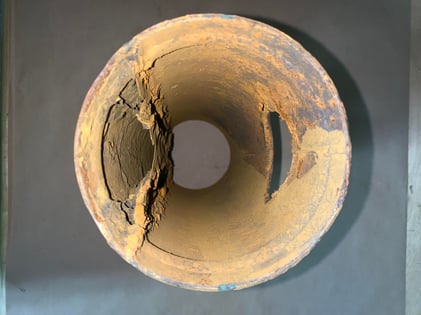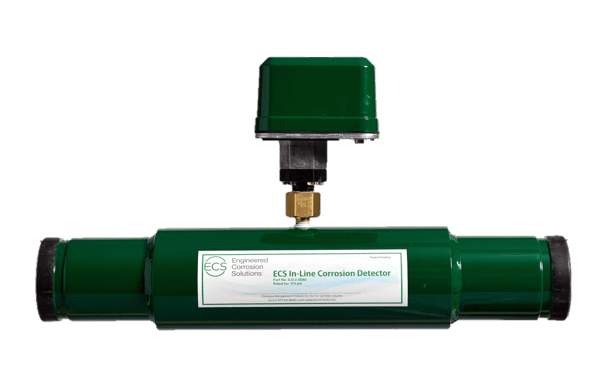Corrosion activity in fire sprinkler systems has been well documented. By far the most common corrosion reaction found in fire sprinkler systems is oxidation. Oxygen trapped inside the system dissolves into water and reacts with the internal surface of the black or galvanized steel piping.
This reaction produces iron oxide debris that eventually results in significant problems, such as:
- Sprinkler pipe obstruction
- Sprinkler plugging
- Reduced hydraulic performance
- Pinhole leaks
- Shortened service life
- Repair costs
- Damage to property
- Business disruption
Unfortunately, there is still a general lack of awareness of corrosion in fire sprinkler systems by building owners and property managers. Most do not realize they have a corrosion problem until they have a leak, when significant piping damage has already occurred. Developing a strategy for corrosion monitoring in sprinkler systems represents a proactive solution to address the unknown condition inside system piping.
Two Categories of Corrosion Monitoring in a Fire Sprinkler System
1) Stand-alone Monitoring System
A stand-alone monitoring system provides early warning of corrosion activity before pursuing a comprehensive corrosion management strategy.
2) Companion to a Deployed Corrosion Management Plan
A companion to a deployed corrosion management plan allows for teams to gauge the effectiveness of the corrosion management plan.
Localized Corrosion Activity

In any corrosive environment physical degradation of the metal can occur in two different ways:
- General thinning of the metal across broad areas which leads to gradual loss of the wall thickness.
- Pitting attack, which results in highly localized loss of the metal at specific points on the pipe surface. Pitting attack is particularly troublesome because it can lead to premature breaches in the pipe wall in an otherwise moderately damaged surface. Most leaks in fire sprinkler system piping occur because of localized pitting corrosion.
Because of the localized nature of corrosion in fire sprinkler systems, corrosion rates vary greatly throughout the piping system. In wet pipe sprinkler systems the corrosion rate will be greatest at the point that is adjacent to any trapped air within the system piping. In dry pipe sprinkler systems the corrosion rate will be greatest where trapped water is present.
As oxygen in the air dissolves into the water it immediately reacts with the first steel it contacts to form iron oxide. So the air/water interface represents the most active corrosion site within these systems. At fluid-packed points within the piping system that are more removed from the trapped air, corrosion rates will be quite low.
In general, the rate of corrosion is directly proportional to the amount of oxygen that is introduced and available.
Given the great variance of corrosion rates in fire sprinkler systems, the placement of a corrosion monitoring device is very important. Improper placement may lead to readings that do not reflect the highest risk for corrosion failure within the system. In general, the closer the monitoring device can be placed to the highly active corroding sites, the better.
Corrosion Monitoring Stations
Historically, the most common type of corrosion monitoring in fire sprinkler systems has been the use of corrosion coupons. In this technique, pre-weighed samples of the subject metal are inserted into the corrosive environment and exposed for a measured period of time. The weight loss relative to the initial weight is used to determine the level of corrosion activity. In order to accurately reflect the corrosion within the system, it is very important that the metal coupons match the piping material and that they be installed at a location where corrosion is most active.
In many industrial process applications it is common to insert removable corrosion coupons at a point within the system piping where they can be easily removed for inspection. Coupon placement within fire sprinkler system piping is restricted because the coupons within the path of water flow can create an obstruction. As a result, corrosion monitoring stations have been installed at the riser to mimic the conditions within the fire sprinkler system piping.
To simulate wet pipe sprinkler systems, a trapped air pocket is created within the station. Corrosion coupons are installed in the stations to measure the effect of oxygen corrosion on the subject metal. Additionally, a thin walled probe can be used to provide an early warning signal through the use of an attached pressure switch.
The approach of using corrosion coupons has several limitations. When installed at the riser, the corrosion monitoring station will likely not see the same environment as the fire sprinkler system piping, e.g. temperature, solids, water flow. The volume of oxygen exposed to metal within the system piping may be significantly higher than the amount present inside the corrosion monitoring chamber. Finally, corrosion coupons are not fully representative of the interior surfaces of the fire sprinkler piping because they do not have an anodic weld seam or the build up of corrosion byproduct solids that can accelerate corrosion activity.
Ideal Corrosion Monitoring for Fire Sprinkler Systems
The ideal corrosion monitoring device would have multiple attributes designed to address the unique nature of corrosion in fire sprinkler systems. It would be sized for installation directly in-line within the fire sprinkler system piping network at the point where oxygen corrosion is expected to be the most severe – where air is trapped in wet pipe sprinkler systems or where water is trapped in dry pipe sprinkler systems.
An in‐line device would be exposed to all of the environmental factors that the system piping sees – flow tests, solids, temperature fluctuations. It would not create an obstruction risk to the water flow within the fire sprinkler system piping. It would provide a 360° interior pipe surface that is identical to the fire sprinkler system piping that would detect corrosion regardless of the water level at that location. It would be composed of the same metal as the fire sprinkler system piping – black or galvanized steel. Finally, it would provide an early warning failure signal to indicate that the corrosion rate has reached an unacceptable level.
 The ECS In-Line Corrosion Detector represents the best option available in the industry to monitor internal corrosion activity in fire sprinkler systems. It is the first and only UL Listed corrosion monitoring device and was recognized as the 2017 Corrosion Innovation of the Year by NACE (National Association of Corrosion Engineers). More importantly, however, it accurately monitors metal loss at the most vulnerable locations within a fire sprinkler system while providing the option for local or remote monitoring signals. This corrosion monitoring device is a valuable investment that notifies building owners and property owners of problems before they become leaks.
The ECS In-Line Corrosion Detector represents the best option available in the industry to monitor internal corrosion activity in fire sprinkler systems. It is the first and only UL Listed corrosion monitoring device and was recognized as the 2017 Corrosion Innovation of the Year by NACE (National Association of Corrosion Engineers). More importantly, however, it accurately monitors metal loss at the most vulnerable locations within a fire sprinkler system while providing the option for local or remote monitoring signals. This corrosion monitoring device is a valuable investment that notifies building owners and property owners of problems before they become leaks.
Learn more about the ECS In-Line Corrosion Detector and other corrosion monitoring products below.



